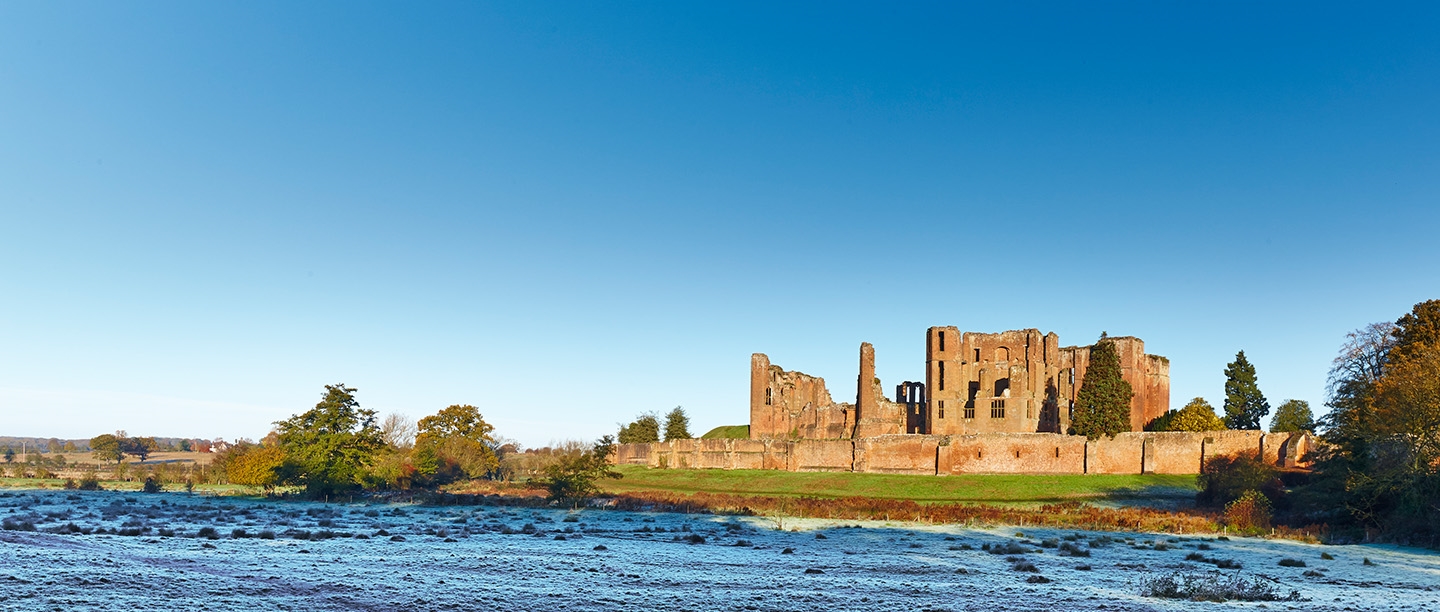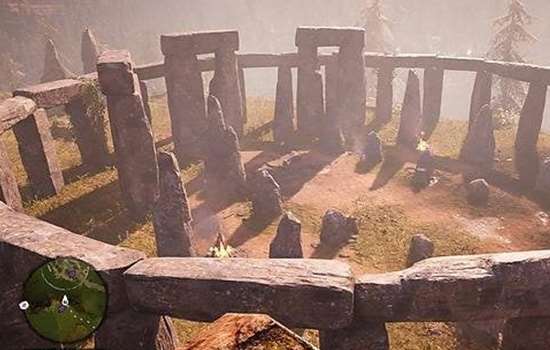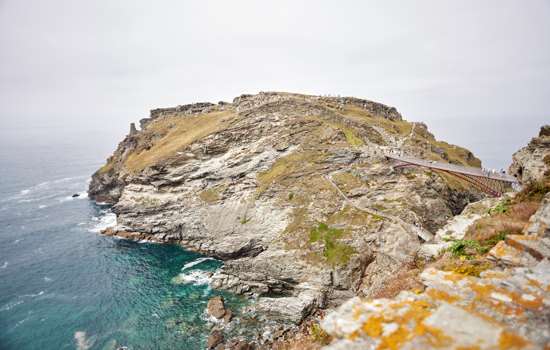
Above: Kenilworth Castle in Warwickshire, which has close associations to Elizabeth I
Castles have long been a cornerstone in the world of fantasy storytelling across literature, TV, film and gaming. While the fortresses described in fiction are often exaggerated, many have parallels with the elaborate style and tactical design of real castles. Here we examine some of the most famous castles and fortified residences in fiction, and some of their real-world counterparts which you can visit for yourself.
Hogwarts – Harry Potter
Though perhaps not considered a castle by most of us, Hogwarts School is described as one in the first of the Harry Potter books by J.K. Rowling:
“Perched atop a high mountain on the other side [of a black lake], its windows sparkling in the starry sky, was a vast castle with many turrets and towers…”
Hogwarts has seven storeys and several looming towers, as well as “a hundred and forty-two staircases: wide, sweeping ones, narrow, rickety ones; some that led somewhere different on a Friday.” In the film series, the castle was brought to life as a vast fortified mansion surrounded on all sides by a lake. Water-defended castles were built throughout medieval England. They included moated manors such as Eltham Palace where the moat can still be seen clearly today, and those – like Hogwarts – built on natural bodies of water.
Kenilworth Castle in Warwickshire is a good example. At half a mile long and up to 150m wide, its vast Great Mere (or lake) was one of the largest man-made water defences in medieval Britain. Geoffrey de Clinton, the chamberlain and treasurer of Henry I, dammed two streams to create the Mere which defended the castle from the south and west sides. This also created a moat to the north and east, surrounding the entire site with water. No evidence has yet been found for merpeople or grindylows.
For a fortress defended by water, however, nowhere is quite as spectacular or as legend-haunted as 13th-century Tintagel Castle in Cornwall. Built partly on the mainland and partly on a dramatic rocky headland, it stands on a site occupied long before by ‘Dark Age’ Cornish rulers, traces of whose buildings you can still see nearby. Stories of the ancient princely stronghold inspired Geoffrey of Monmouth to link the site with the legendary King Arthur, and Earl Richard of Cornwall staked his claim on the legend by raising Tintagel Castle there. Built primarily for this reason, rather than to defend anything in particular, Tintagel could itself be described as a kind of fantasy castle.
While moving staircases are restricted to the realms of Harry’s wondrous world, some real world castles may also have been designed to cause confusion. The many coastal ‘device forts’ constructed by Henry VIII due to fears of Catholic attack from the continent have a flower-like shape. This includes a central keep surrounded by round bastions. Deal Castle, a typical Henrician fort on the Kent coastline, features a circuit of dark winding passages known as ‘the Rounds’, which zig-zag right round the lowest level of the keep, and can still be explored today. Studded with loopholes for over 50 guns, they were designed to allow the defenders to mow down besiegers who’d got into the surrounding dry moat. But they would also confuse and disorientate any intruders who found their way into the passages themselves, since every section looks the same. While the invaders (literally) ran around in circles and lost track of where in the building they were, the resident defenders – with their knowledge of the layout, and the ability to shoot intruders through gun loops within the passage walls – would gain the upper hand. Try it for yourself, and you may soon lose your bearings!
Castle Grayskull – Masters of the Universe
Mattel’s Masters of the Universe franchise was launched in the 1980s. The heroic He-Man, alter ego of Prince Adam, fought it out with the evil Skeletor across a series of films, toys and TV shows.
Castle Grayskull, the central location of the stories, takes the shape of a classic tower-cornered keep or donjon. The ‘fortress of mystery and power’ is best known for its fearsome ‘jawbridge’, a tooth-lined drawbridge allowing entry through the sinister skull-face gatehouse. According to the television series, Grayskull is situated above a ‘bottomless abyss’ so that anybody unfortunate enough to fall from the jawbridge would be lost for all eternity.
Pits of this sort (though a little shallower!) are often found beneath the drawbridges of medieval castles, such as at Dover Castle in Kent. In the forebuilding here, you can still see down into the drawbridge pit that formed a final hurdle for any attackers able to get within the Great Tower’s walls. Look up, and you’ll see where the entrance-way was open to the sky, allowing archers to pick off invading forces. Entering through here would have been no mean feat.
The square structure of Castle Grayskull is cornered by four cylindrical turrets, creating a striking resemblance to Somerset’s Nunney Castle. Though he wasn’t a prince with superhuman strength and a Power Sword, Nunney Castle’s builder – Sir John Delamare – was a knight. Delamare had been a soldier during the Hundred Years War, and obtained the licence to crenellate from Edward III in 1373, permitting him to fortify his existing manor house and create the castle whose remains still stand today.
Minas Tirith – Lord of the Rings
Surely one of the mightiest fortresses on our list, the city of Minas Tirith, sits at the base of a mountain on the Pelennor Fields in the province of Anórien. Built on the rocky Hill of Guard, the city is best described as a multi-ringed fortress, with concentric layers of fortifications built upon a natural mound.
“For the fashion of Minas Tirith was such that it was built on seven levels, each delved into the hill, and about each was set a wall, and in each was a gate. But the gates were not set in a line: the Great Gate in the City wall was at the east point of the circuit, but the next faced half south, and the third half north, and so to and fro upwards; so the paved way that climbed toward the citadel turned this way and that and then that across the face of the hill.” (The Return of the King, Chapter 1)
Multi-ringed fortresses developed in Britain during the Iron Age, when massive ‘hill forts’ such as Maiden Castle in Dorset were built. The site was first occupied around 6,000 years ago, but during the Iron Age it was transformed into a vast fortified settlement with multiple earthwork ramparts and ditches. What began as a small self-sustaining community grew over the centuries to become the pre-eminent settlement in southern Dorset. Its many winding ramparts and ditches (echoing the offset entrances of Minas Tirith’s tiers) make Maiden Castle the largest and most complex Iron Age hillfort in Britain, and among the biggest in Europe.
Old Sarum near Salisbury also began as an Iron Age fortification, which may have been established as early as 400 BC. The settlement was later occupied by the Romans (when it became known as Sorviodunum) and then the Normans, who built a castle and cathedral there. Today, you can climb up the mighty prehistoric ramparts and enjoy panoramic views from the top, including to the modern city of Salisbury. Other examples of ring-structured forts include Old Oswestry, probably the stronghold of an Iron Age tribe. Old Oswestry and Maiden Castle are both free to visit today.
The Eyrie – Game of Thrones
One of the more dramatic examples of a fictional fortification is the Eyrie from TV’s Game of Thrones, a towering stronghold whose impregnability lies fundamentally in its height. The castle is perched atop an enormous peak in the ‘Mountains of the Moon’. Those who approach it are forced into vulnerable single-file formation by a long approach bridge, before facing a spiraling mountain path. Here, three way-castles – appropriately named Stone, Snow and Sky – have holes in the floor, allowing defenders to drop rocks and oil on those coming from beneath. This defence technique was used at many medieval castles, which feature devices such as the gruesomely named ‘murder holes’ at Dover Castle. However, soldiers there would generally rain arrows on the attackers rather than hot oil or boulders. The Eyrie is perhaps most famous for its ‘sky cells’, a ‘stone honeycomb’ of horrifying prison rooms which are open on one side with sloped floors exposing inmates to the howling cold and a deadly drop. Driven insane by the freezing wind, many would leap to their deaths rather than endure the grim conditions. Surely no real castle resembles this fearsome place?
Well, not precisely. But the Eyrie has many similarities to features of England’s historic strongholds. Height was an easy win when building a castle. Situating a fortress on an existing hill or mountain gave the occupiers an immediate advantage over any potential attacker. The benefits of a hilltop castle were twofold: increased visibility of the surrounding landscape, and reduced accessibility for the attackers. It is partly for this reason (and also as a symbol of power) that the spectacular ruin of Beeston Castle crowns a rocky crag in rural Cheshire. Adapting the defences of an Iron Age hillfort, the castle unusually doesn’t feature a keep, but – much like the Eyrie – used the natural cliffs to defend an inner ward. Beeston is described in medieval writings as ‘Castellum de Rupe’, the Castle on the Rock.
However, the benefits of an elevated position are balanced by logistical difficulties like the provision of water. At Beeston, two wells were dug down through the rock to provide a supply. One of them, at over 100 metres (328 feet) deep, is the deepest castle well in England and is rumoured to be the hiding place of Richard II’s lost treasure. Like its counterpart in the Seven Kingdoms, Beeston Castle also served as a prison of sorts. References to prisoners throughout the Middle Ages suggest that it may have been a secure place to keep hostages. In 1264, Edward I visited the castle with prisoners taken after the Battle of Evesham. It was also used by Henry III as a prison for captives in his wars with Wales.
“Gods save me, the blue is calling.” (Wall writing by a previous prisoner in Tyrion Lannister’s sky cell)
As for the sky cells of the Eyrie that held Tyrion Lannister and drove their unfortunate inmates to madness, the prisons and dungeons of England’s castles are not without their own horrors. When the Jacobite rising was extinguished in 1746, the Hanoverian government kept up to 300 prisoners at Carlisle Castle in Cumbria. During the hot summer of that year, 90 prisoners were crammed into the small dungeon cells to await trial. It must have been dark, and smelly. And without water, some men died. But small erosions in the rock walls of the cells collected what little damp there was, and so the prisoners were forced to take advantage. They licked the walls to stay alive.
Princess Peach’s Castle – Super Mario 64
The castles of popular culture are not limited to film and TV, but have also appeared in video games since their conception. In the Mario series, a castle and flagpole indicated the final challenge of a world. Over time the classic red-brick crenelated design evolved into Princess Peach’s Castle in Super Mario 64 with its tall central tower and corner turrets. It’s colourful, symmetrical, and guarded by toads.
“So this is Peach’s Castle…it’s more beautiful than I imagined!” (Penguru, Super Mario Galaxy)
The castle stands in a grassy valley, and is surrounded by a deep moat which is crossed via a central bridge. Many medieval castles and fortified houses featured similar designs, including the now ruined Goodrich Castle in Herefordshire, and the striking red-brick fortified manor house of Kirby Muxloe Castle in Leicestershire. While the moats of medieval castles served as a physical barrier to attackers, those around fortified manor houses such as Kirby Muxloe were often built for aesthetic reasons. An impressive moat was a symbol of status and provided a pleasing reflected view of the castle, enhancing its scale and grandeur. William, Lord Hastings fortified the house at Kirby Muxloe from 1480, and diverted a brook to feed the newly-dug moat which it still retains today. However, in 1483, his high ambitions for the building were cut short when he was dramatically executed.
Princess Peach’s home is also iconic for its four point-roofed turrets, which project from the corners of the rectangular building. A similar design is found at Farleigh Hungerford Castle in Somerset. Though now largely ruined, a rectangular enclosure here was originally cornered by four pointed towers*. However, while Nintendo’s creation has a tall central spire, Farleigh Hungerford was a ‘quadrangular’ castle, built with four ‘ranges’ of buildings enclosing a central courtyard rather than a keep. With its proximity to the River Frome, you might even spot a toad or two.
*towers rise from ground level, while turrets may project from the walls of a building
Discover more places with links to fiction
From Shakespeare’s “worm-eaten hold of ragged stone” to Thomas Hardy’s “very Temple of the Winds,” many of our historic places feature in the world of fiction. Discover more literary links on our website.
For more from English Heritage, follow us on Facebook, Twitter and Instagram.
MOVIE AND VIDEO GAME IMAGES ARE USED HERE FOR EDITORIAL PURPOSES AND REMAIN THE PROPERTY OF THEIR RESPECTIVE OWNERS. FOR ENQUIRIES CONTACT CONTENT@ENGLISH-HERITAGE.ORG.UK.
More to explore
-

Playing with the Past
With fascinating stories and worlds so different from our own today, these are just some of the video games to have notably drawn inspiration from England's rich history.
-

ENGLAND: A SPORTING NATION
Sports historian Nigel à Brassard takes a closer look at the sporting history of England, a nation at the forefront of creating and codifying games and sports.
-

English place names
Have you ever driven through a town and curiously pondered (or perhaps sniggered) over its name? Well, it turns out there's a story behind every one...